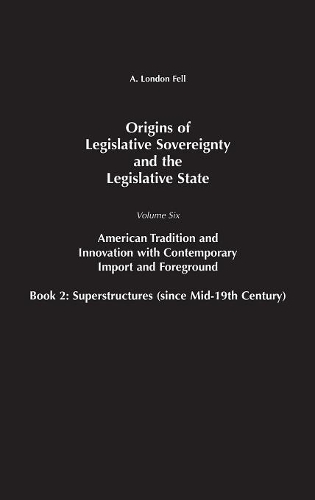
Origins of Legislative Sovereignty and the Legislative State: Volume Six, American Tradition and Innovation with Contemporary Import and Foreground Book II: Superstructures (since Mid-19th Century)
(Hardback)
Available Formats
Hardback
Published: 25th March 1991
Hardback
Published: 14th September 1993
Hardback
Published: 23rd May 1996
Hardback
Published: 30th September 1999
Hardback
Published: 30th July 2004
Hardback
Published: 29th September 2010
Hardback
Published: 28th February 2008
Hardback
Published: 30th September 2006
Hardback
Published: 4th December 2009
Publishing Details
Origins of Legislative Sovereignty and the Legislative State: Volume Six, American Tradition and Innovation with Contemporary Import and Foreground Book II: Superstructures (since Mid-19th Century)
By (Author) A. London Fell
Bloomsbury Publishing PLC
Praeger Publishers Inc
30th September 2006
United States
Classifications
Tertiary Education
Non Fiction
Central / national / federal government
Systems of law
340.09
Physical Properties
Hardback
348
Width 156mm, Height 235mm
652g
Description
In keeping with the preceding book on the American Founders, this volume deals mostly with U.S. Presidents and their ideas in the 19th and 20th centuries, from Lincoln (along with his contemporaries Davis and Stevens), Theodore Roosevelt, and Wilson, to Franklin Roosevent, Lyndon Johnson, and Reagan. Part One centers on Civil War and Reconstruction; Part Two on Progressivism and New Deal;' and Part Three on Toward Contemporary America. In all three, the overriding concern will be with Legislative Perspectives of Sovereignty and State. In the mid-19th century, the main central imprints of Abraham Lincoln upon the Union, of Jefferson Davis upon the Confederacy, and of Thaddeus Stevens upon Reconstruction were manifested in ways crucial to this study. Throughout the 20th century, there was a long succession of Presidents whose chief slogans signaled the country's main agenda during their Administrations. Most prominent were Theodore Roosevelt's Square Deal, and New Nationalism, Woodrow Wilson's New Freedom, Franklin Roosevelt's New Deal, John Kennedy's New Frontier, Lyndon Johnson's Great Society, and Ronald Reagan's Revolution in government. In these cases, Presidential viewpoints on legislative sovereignty and the legislative state had great impact upon the nation as well as on Congress, notwithstanding the separation of powers. Certain contemporary points of view also loom large. Some emerging hopeful trends toward an American neo-Progressivism are considered, taking their lead from historical frameworks explored in the main body of the book.
Reviews
The first book of Volume Six looked at the foundations from the late 18th to the early 19th centuries, and this second looks at the superstructures built upon those foundations from Abraham Lincoln to Ronald Reagan. The three parts focus on the Civil War and Reconstruction, Progressivism and the New Deal, and toward contemporary America. He finds that later leaders and paradigm-builders were not as aware of European antecedents as the Founders were. * Reference & Research Book News *
Author Bio
A. London Fell has taught at New York and Fordham Universities. He is semi-retired.
